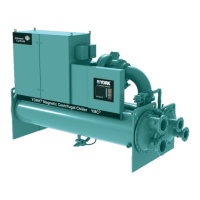JOHNSON CONTROLS
FORM 160.84-EG1 (617)
28
The chillers can tolerate a 50% flow rate change in one minute that is typically associ-
ated with the staging on or off of an additional chiller; however a lower flow rate change is
normally used for better system stability and set point control. Proper sequencing via the
building automation system will make this a very smooth transition.
Temperature Ranges – For normal water chilling duty, leaving chilled water tempera-
tures may be selected between 38°F (3.3°C) [36°F (2.2°C) with Smart Freeze enabled]
and 70°F (21.1°C) to obtain temperature deltas between entering chilled and leaving
chilled water temperature of 3°F up to 30°F (1.7°C and 16.7°C).
Water Quality – The practical and economical application of liquid chillers requires that
the quality of the water supply for the condenser and evaporator be analyzed by a water
treatment specialist. Water quality may affect the performance of any chiller through cor-
rosion, deposition of heat-resistant scale, sedimentation or organic growth. These will
degrade chiller performance and increase operating and maintenance costs. Normally,
performance may be maintained by corrective water treatment and periodic cleaning of
tubes. If water conditions exist which cannot be corrected by proper water treatment, it
may be necessary to provide a larger allowance for fouling, and/or to specify special ma-
terials of construction.
General Piping – All chilled water and condenser water piping should be designed and
installed in accordance with accepted piping practice. Chilled water and condenser wa-
ter pumps should be located to discharge through the chiller to assure positive pressure
and flow through the unit. Piping should include offsets to provide flexibility and should
be arranged to prevent drainage of water from the evaporator and condenser when the
pumps are shut off. Piping should be adequately supported and braced independently of
the chiller to avoid the imposition of strain on chiller components. Hangers must allow for
alignment of the pipe. Isolators in the piping and in the hangers are highly desirable in
achieving sound and vibration control.
Convenience Considerations – To facilitate the performance of routine maintenance
work, some or all of the following steps may be taken by the purchaser. Evaporator and
condenser water boxes are equipped with plugged vent and drain connections. If desired,
vent and drain valves may be installed with or without piping to an open drain. Pressure
gauges with stop-cocks and stop-valves may be installed in the inlets and outlets of the
condenser and chilled water line as close as possible to the chiller. An overhead monorail
or beam may be used to facilitate servicing.
Connections – The standard chiller is designed for 150 psig (10.3 barg) design working
pressure in both the chilled water and condenser water circuits. The connections (water
nozzles) to these circuits are furnished with grooves to ANSI/AWWA C-606 Standard for
grooved and shouldered joints. Piping should be arranged for ease of disassembly at the
unit for tube cleaning. All water piping should be thoroughly cleaned of all dirt and debris
before final connections are made to the chiller.
Chilled Water – A water strainer of maximum 1/8" (3.2 mm) perforated holes must be
field-installed in the chilled water inlet line as close as possible to the chiller. If located
close enough to the chiller, the chilled water pump may be protected by the same strainer.
The strainer is important to protect the chiller from debris or objects which could block flow
through individual heat exchanger tubes. A reduction in flow through tubes could seriously
impair the chiller performance or even result in tube freeze-up. A thermal-type flow switch
is factory installed in the evaporator nozzle and connected to the OptiView panel, which
assures adequate chilled water flow during operation.
Application Data (Cont'd)

